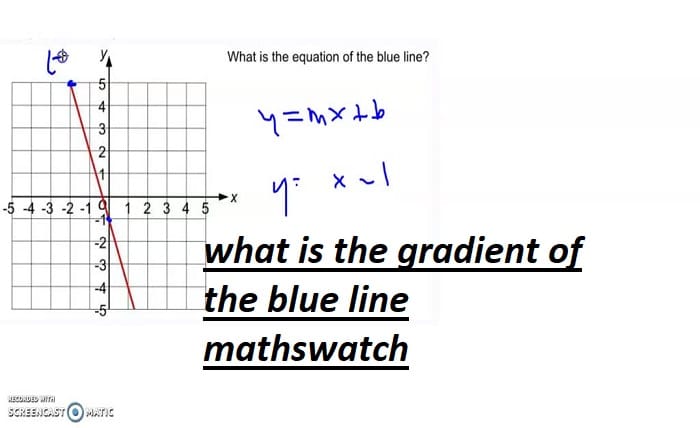The Gradient of the Blue Line: A Mathswatch Guide

In mathematics, the gradient of a line refers to its steepness or slope. On Mathswatch, the blue line often serves as a visual aid to help students understand this concept. The gradient of the blue line Mathswatch can be determined by examining the vertical change (rise) and the horizontal change (run) between two points on the line. By following the instructions provided on Mathswatch, students can calculate the gradient, which is expressed as a ratio or a fraction.
Mathswatch’s approach to teaching gradients makes it easy for learners to grasp this foundational concept. Through interactive videos and practice exercises, students learn to identify and interpret the gradient of the blue line Mathswatch, building their confidence and skills in solving linear equations and graph-related problems.
Why the Gradient of the Blue Line Mathswatch Matters
Understanding the gradient of the blue line mathswatch is crucial for several reasons. Firstly, it lays the groundwork for more advanced topics in algebra and calculus. By mastering the gradient of the blue line Mathswatch, students develop a deeper appreciation for linear relationships and the role of slope in mathematical equations.
Secondly, this knowledge has practical applications. The gradient of the blue line Mathswatch provides insights into real-world phenomena, such as rates of change, incline of roads, and trends in data analysis. Mathswatch simplifies this learning process by breaking down complex ideas into manageable steps, ensuring that students gain a strong foundation in mathematical reasoning.
How to Calculate the Gradient of the Blue Line Mathswatch
Determining the gradient of the blue line Mathswatch involves a straightforward calculation. Follow these steps:
- Identify Two Points: Select any two points on the blue line. Mathswatch often provides these points clearly in exercises.
- Find the Vertical Change (Rise): Calculate the difference in the y-coordinates of the two points.
- Find the Horizontal Change (Run): Calculate the difference in the x-coordinates of the two points.
- Divide the Rise by the Run: The gradient of the blue line Mathswatch is the ratio of the rise to the run, expressed as a fraction or a decimal.
By practicing these steps on Mathswatch, students become adept at finding the gradient of the blue line Mathswatch and applying this method to various mathematical problems.
Common Mistakes When Identifying the Gradient of the Blue Line Mathswatch
While the concept of the gradient of the blue line Mathswatch is simple, there are common mistakes that students should avoid:
- Reversing Coordinates: Mixing up x and y coordinates can lead to incorrect gradient calculations.
- Forgetting to Simplify Fractions: Simplifying the fraction representing the gradient ensures clarity and accuracy.
- Ignoring Negative Signs: The gradient of the blue line Mathswatch can be negative, indicating a line that slopes downward. Neglecting the sign leads to incorrect interpretations.
- Not Using Clear Points: Choosing unclear or approximated points on the blue line can result in inaccuracies. Mathswatch’s exercises typically provide precise points to avoid this.
By recognizing these pitfalls, students can confidently calculate the gradient of the blue line Mathswatch without error.
Real-Life Applications of the Gradient of the Blue Line Mathswatch
The gradient of the blue line Mathswatch isn’t just a theoretical concept; it has practical applications that extend beyond the classroom:
- Engineering and Construction: Gradients are used to determine the slope of roads, ramps, and structures. Understanding the gradient of the blue line Mathswatch helps future engineers and architects make precise calculations.
- Physics and Motion: In physics, the gradient of a line on a graph can represent velocity or acceleration. The gradient of the blue line mathswatch introduces students to these foundational ideas.
- Data Analysis: In statistics, the slope of a trend line indicates the relationship between variables. By learning about the gradient of the blue line Mathswatch, students gain the skills needed to interpret data trends and make informed predictions.
These real-world connections highlight the importance of mastering the gradient of the blue line Mathswatch.
Tips for Mastering the Gradient of the Blue Line Mathswatch
To excel in finding the gradient of the blue line Mathswatch, consider the following strategies:
- Practice Regularly: Use Mathswatch exercises and videos to reinforce your understanding of gradient concepts.
- Visualize the Line: Look closely at the blue line on the graph to understand its direction and steepness before calculating.
- Work Through Examples: Follow step-by-step examples on Mathswatch to see how gradients are calculated in different scenarios.
- Ask Questions: If you encounter difficulties, don’t hesitate to seek help from teachers or peers familiar with Mathswatch.
- Review Mistakes: Analyze errors in past attempts to ensure you’re improving your approach to finding the gradient of the blue line Mathswatch.
By following these tips, you’ll become proficient at determining the gradient of the blue line Mathswatch.
Conclusion
The gradient of the blue line Mathswatch is a fundamental concept in mathematics that plays a vital role in understanding linear relationships and solving graph-based problems. With Mathswatch’s interactive tools, video tutorials, and practice exercises, students can master this skill in no time. By consistently applying the methods outlined above and leveraging Mathswatch’s resources, learners can confidently calculate and interpret the gradient of the blue line Mathswatch, paving the way for success in more advanced mathematical topics.
FAQs
1. What does the gradient of the blue line Mathswatch represent?
The gradient of the blue line Mathswatch represents the slope or steepness of the line, calculated as the ratio of vertical change to horizontal change.
2. How can I find the gradient of the blue line Mathswatch?
You can find the gradient of the blue line Mathswatch by selecting two points on the line, determining the rise and run, and dividing them to get the slope.
3. Why is the gradient of the blue line Mathswatch important?
Understanding the gradient of the blue line Mathswatch is important because it helps students grasp linear relationships and apply these concepts in real-world scenarios.
4. Can the gradient of the blue line Mathswatch be negative?
Yes, the gradient of the blue line Mathswatch can be negative if the line slopes downward from left to right.
5. How can Mathswatch help me understand the gradient of the blue line Mathswatch?
Mathswatch provides step-by-step video tutorials, clear examples, and interactive exercises that guide you through the process of finding and interpreting the gradient of the blue line Mathswatch.




